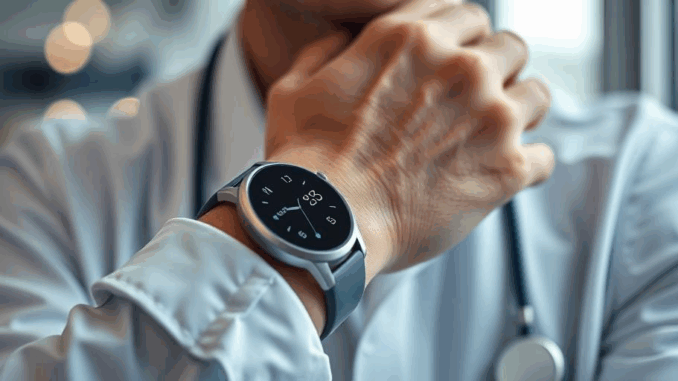
Summary
Wearable sweat stickers are revolutionizing real-time health monitoring. These innovative devices offer a non-invasive way to track various biomarkers, paving the way for personalized medicine and earlier disease detection. From monitoring hydration and electrolyte balance to detecting chronic conditions, sweat stickers are transforming how we approach healthcare.
TrueNAS by Esdebe: healthcare data storage that delivers value without sacrificing security.
** Main Story**
Sweat. We all do it, right? It’s more than just an annoying byproduct of a tough workout or a nerve-wracking presentation; it’s actually a treasure trove of information about what’s going on inside our bodies. Now, brilliant minds are turning this readily available biofluid into something extraordinary: wearable ‘sweat stickers’.
These aren’t your grandma’s Band-Aids. These are tiny, unobtrusive devices that stick to your skin and analyze the very composition of your sweat. Imagine getting real-time insights into your health, simply by wearing a sticker. Pretty cool, huh?
This article’s all about the exciting progress in wearable sweat sticker technology and their power to change health monitoring as we know it.
A Less Invasive Way to Look at Your Health
Let’s face it, traditional health monitoring can be a pain. Blood draws? Nobody likes those. Cumbersome equipment? Not exactly convenient. Wearable sweat stickers, though, offer a painless and super convenient alternative, wouldn’t you agree?
These stickers pack a punch. They’re loaded with miniaturized sensors and microfluidic channels, all cleverly designed to capture and analyze your sweat. As sweat flows through, the sensors pick up on various biomarkers: electrolytes, metabolites, hormones, even indicators of specific diseases. And the best part? That data can be beamed wirelessly to your phone or another device for real-time monitoring and analysis. It’s like having a mini-lab stuck right on your skin!
So Many Uses!
The range of potential uses for wearable sweat stickers is mind-boggling. We are talking a wide spectrum of health and wellness areas:
- Personalized Fitness and Hydration: Athletes, fitness fanatics – listen up! These stickers can monitor your electrolyte balance, hydration levels, and nutrient loss in real-time. You can use this data to fine-tune your training, avoid dehydration, and boost your overall performance. Imagine knowing exactly when to replenish those electrolytes during a marathon. That’s a game-changer.
- Chronic Disease Management: Sweat stickers are a promising tool for managing long-term conditions like diabetes, cystic fibrosis, and cardiovascular disease. By constantly tracking key biomarkers, patients and doctors can get a better handle on how a disease is progressing, whether medications are working, and any potential complications. It’s like having a continuous health report card, right on your skin.
- Early Disease Detection: This is where things get really exciting. Researchers are exploring using sweat stickers to detect diseases early, including certain cancers. Specific biomarkers in sweat could act as early warning signs, which, of course, allows for faster intervention and potentially life-saving treatment.
- Medication Monitoring: These stickers could also monitor medication levels, making sure you’re getting the right dose to minimize side effects.
- Mental Health Monitoring: Believe it or not, scientists are even looking into using sweat stickers to detect biomarkers related to stress and other mental health issues. Imagine a new way to monitor and manage your mental well-being. I mean that’s pretty awesome isn’t it?
Tech That Makes it Possible
Recent leaps in materials science, microfluidics, and sensor technology have really fueled the progress of these sweat stickers. For example, 3D printing lets researchers create those crazy intricate microfluidic designs within the stickers, optimizing sweat collection and analysis. Plus, flexible and stretchable materials ensure they’re comfy and stay put, even during long-term wear. And, of course, wireless communication lets them send data seamlessly for remote monitoring.
What’s Next?
Okay, the technology’s impressive, but it’s not perfect. Ensuring accuracy and reliability across different people and environments is key. We need more research to fully understand how sweat biomarkers relate to what’s happening inside our bodies. And, naturally, making them smaller and cheaper will be essential for widespread adoption. My personal opinion, they should be intergrated into smart watches, like the new Apple Watch ultra!
But the future? It looks incredibly bright. Researchers are constantly finding new uses and making the technology better. As sweat stickers become more advanced and affordable, they could really change how we manage our health, enabling proactive, personalized medicine for everyone. These stickers are poised to become essential, and I think it’s safe to say, were on the path to a healthier, more connected future.


Given the potential for real-time data transmission, how is the security of patient data ensured, particularly regarding unauthorized access or potential breaches of privacy regulations like HIPAA?
That’s a crucial point! Data security is paramount. The devices employ robust encryption methods during data transmission and storage. Compliance with HIPAA and similar regulations is a core design principle, often involving anonymization techniques and secure cloud platforms. The focus is on building trust through verifiable security measures. What other applications do you think could be incorporated?
Editor: MedTechNews.Uk
Thank you to our Sponsor Esdebe
Given the potential integration with smartwatches, how might the continuous data stream from sweat stickers be filtered and interpreted to prevent overwhelming users with irrelevant information?
Great question! I think a tiered approach would be beneficial. A basic level could provide general wellness data, while a more advanced level could offer detailed insights based on user-defined thresholds or specific health goals. Machine learning could also play a role in filtering and prioritizing relevant information. What are your thoughts?
Editor: MedTechNews.Uk
Thank you to our Sponsor Esdebe